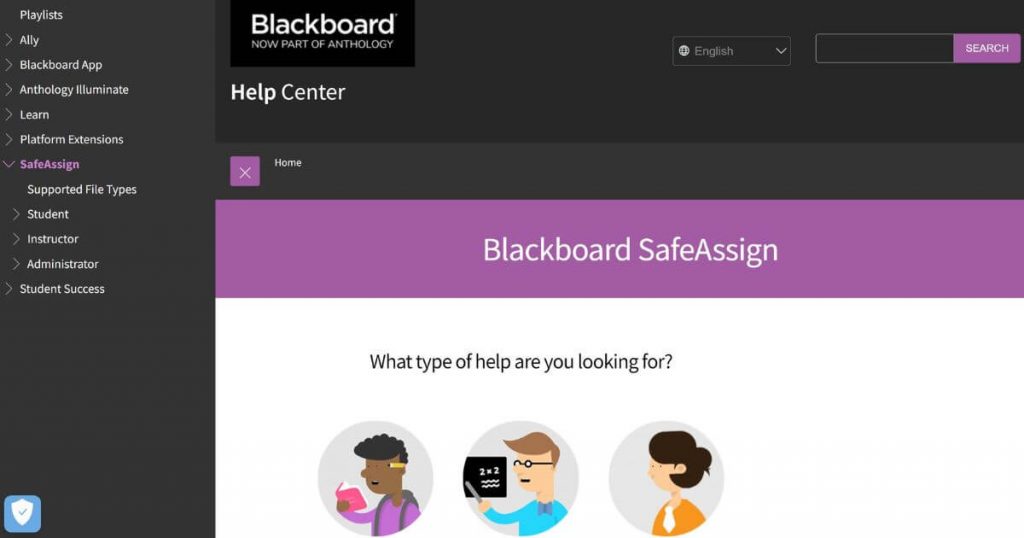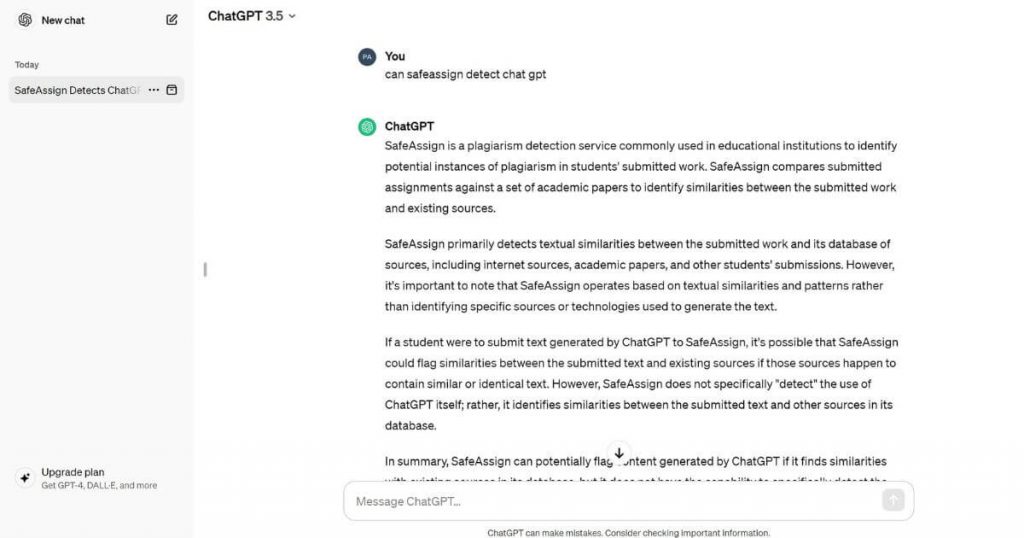Are you curious about SafeAssign’s ability to detect content generated by ChatGPT? It’s a question that has crossed the minds of many, myself included.
The word on the street is that content such as what ChatGPT produces might just slip under SafeAssign’s radar. To shed some light on this matter, I’ve plunged into the intricacies of plagiarism detection when it comes to text churned out by artificial intelligence (AI) giants like ChatGPT.
My extensive analysis has revealed some fascinating insights about the crossroads of academic integrity and advanced technology. Stay with me—what I’ve uncovered might just alter your perspective on writing in our tech-savvy era!
Does SafeAssign Detect ChatGPT? [Key Takeaways]
- SafeAssign may struggle to detect content generated by Chat GPT due to its unique nature and the limitations of traditional plagiarism detection methods.
- ChatGPT does not plagiarize, but its lack of proper citation could lead to unintentional plagiarism, blurring the line between original work and AI-generated assistance.
- To enhance its ability to effectively detect plagiarism, SafeAssign can revise its detection algorithms, embrace advanced AI technology, partner with AI experts, continuously supervise and adopt novel methods of content creation, and raise users’ awareness about AI-generated pieces, such as those generated by ChatGPT.
Understanding SafeAssign and ChatGPT
Let’s start with a brief introduction to the main heroes in my story: ChatGPT and SafeAssign.
What is SafeAssign?

SafeAssign is a widely used plagiarism detection tool in various educational institutions. It’s integrated with the Blackboard Learning System. This tool compares student submissions to a vast database of academic papers, while ChatGPT is an AI language model capable of generating human-like text based on prompts.
How does SafeAssign work?
I often use tools like SafeAssign to verify the originality of my work. Here’s how it works: I upload my paper, and SafeAssign scans it, looking for matches with texts in its large database of academic papers, including previously submitted works by other students.
If it finds parts that match other texts, it flags them so I can make sure my work is truly my own. This tool helps me avoid copying by accident and keeps my writing authentic.
This plagiarism checker isn’t just a comparison of words; it understands the meaning behind them, too. Using complex algorithms and a bunch of smart tech, it analyzes the text deeply.
Every time I submit a paper through this system, I’m teaching myself to be more original and careful with sources.
“SafeAssign educates as well as detects. Teachers can use this tool to identify plagiarism and teach pupils about academic integrity and citation. It can discourage plagiarism by warning pupils of the risks and encouraging them to write independently.” — Jason Wise, Editor, EarthWeb
ChatGPT and academic writing
ChatGPT is an AI chatbot, developed by OpenAI, that has expertise in various fields and can assist you with various tasks. It’s smart because it uses natural language processing, which is just a fancy way of saying it can understand and make sentences like a human.
But here’s the thing: when you ask ChatGPT to write something, it doesn’t copy from books or the web. Instead, it generates unique content from what it has learned. This is different from old-school cheating, where people would take someone else’s words and claim them as theirs. ChatGPT doesn’t do that. Every time it writes, the words are fresh and new.
So, if someone tries to catch it copying others’ work using software like SafeAssign, they might not find anything because, technically, everything ChatGPT writes hasn’t been written before by anyone else.
ChatGPT excels in generating ideas, outlining content, and offering creative insights. While ChatGPT can aid in the writing process, you must contribute your own knowledge, verify information, and maintain the integrity of your work. Ultimately, a balanced and informed approach ensures the effective integration of ChatGPT into academic writing practices.
Want to learn some helpful tactics? Here’s how to avoid ChatGPT detection.
Can Blackboard SafeAssign Detect Chat GPT Content?
No, SafeAssign is not equipped to spot content created by AI tools like ChatGPT. This plagiarism checker relies on text comparison and database checks, which might not effectively identify AI-generated text due to its unique nature.
This limitation raises questions about the tool’s effectiveness in detecting modern forms of plagiarism, such as inadvertently plagiarizing AI content and the unethical use of paraphrasing tools.
When it comes to detecting ChatGPT-generated content, some online AI detectors might also struggle. The complex nature of how these deep learning algorithms produce text can make it challenging for traditional plagiarism detection software to recognize and flag such content accurately.
Here’s what ChatGPT “thinks” when asked, “Can SafeAssign detect Chat GPT”:

“Тhere might be situations where educators can deduce AI-generated content using SafeAssign. For example, if two individuals request the same information from an AI, there’s a possibility it generates nearly identical sentences. You can test this by asking ChatGPT the same question in two separate chat sessions. It does have some randomness, but it could pose a risk if the outcome is submitted to a plagiarism checker.” — Lucas Ochoa, CEO and Founder, Automat
Does ChatGPT Plagiarize? Exploring the Nuances
Understanding the nuances of ChatGPT and plagiarism is crucial. ChatGPT itself doesn’t plagiarize, as it generates text based on patterns from existing data. However, when someone uses ChatGPT to produce content without proper citation or acknowledgment, it could lead to unintentional plagiarism.
This obscures the distinction between original work and AI-generated assistance, making it challenging for a conventional plagiarism checker like SafeAssign to distinguish.
ChatGPT’s ability to mimic human-like responses raises questions about its role in academic integrity. While it’s not intentionally plagiarizing, the challenge lies in using this powerful tool responsibly, ensuring that any outputs are appropriately attributed and cited to maintain authenticity in academic literature.
How SafeAssign Can Improve AI Detection
SafeAssign can improve detection by incorporating AI and machine learning techniques to identify ChatGPT-generated content and adapting its algorithms to recognize the patterns in AI-generated texts.
Possible solutions for improving SafeAssign’s accuracy with ChatGPT are:
- Update detection algorithms and embrace AI technology: SafeAssign should consider updating its detection algorithms to keep pace with advancements in AI and chatbots like ChatGPT. Integrating AI technology would help SafeAssign accurately identify and flag any content produced by these AI models.
- Collaborate with AI experts: SafeAssign could benefit from collaborating with AI experts to develop strategies for identifying text generated by ChatGPT, leveraging their expertise in machine learning techniques and textual analysis.
- Continuous monitoring and adaptation: SafeAssign should continuously monitor and adapt to new methods of content creation, including those facilitated by AI technologies, to ensure that it remains effective in detecting potential plagiarism from these sources.
- Educate users on AI-generated content: SafeAssign can also play a role in educating users about the potential of AI content, helping them understand the implications of using such technology in their academic work, and promoting ethical writing practices.
“One of the biggest challenges is the ever-changing nature of AI content. AI models like ChatGPT are constantly learning and evolving. Static algorithms like SafeAssign can’t keep up with this. It needs more dynamic algorithms that evolve with AI models, contextual analysis to understand the intent behind the text, and academic-to-tech partnerships for continuous improvement.” — James Smith, Founder, Travel-Lingual
Explore which AI checkers for teachers are helping them recognize non-human written content.
Importance of Adapting to New Forms of Academic Dishonesty
Adapting to new forms of academic dishonesty, like AI-written content, is crucial. With the rise of tools such as ChatGPT, traditional plagiarism detection methods may not be effective.
It’s important to recognize these changes and proactively seek solutions for accurate plagiarism detection and prevention. Staying updated on emerging technologies like AI in academia can help us navigate potential pitfalls and maintain academic integrity within our content.
Fortunately, there are plenty of other online tools that can identify AI content. Find out more about whether Turnitin, for example, can detect ChatGPT here.
Conclusion
While sometimes SafeAssign can detect content generated by ChatGPT or other AI language models, its effectiveness may vary. There are ongoing discussions and concerns about the limitations of SafeAssign in detecting AI-generated texts.
It’s important to continue exploring and adapting detection methods to keep up with advancements in technology and academic dishonesty.
FAQ
Does SafeAssign detect AI?
SafeAssign is a plagiarism detection tool that checks any type of student submissions, such as essays and research papers, for copied work. It looks through its extensive database to see if someone else wrote the same words. It is designed to catch verbatim plagiarism, so no, it can’t detect ChatGPT or AI in general.
Why might someone use ChatGPT to write papers?
ChatGPT is an AI chatbot that can write like a person. Some people might use it to quickly create information for their school work or paraphrase their sentences to sound better.
Are there any tools that catch plagiarized AI writing?
Yes, there are AI detection tools like Turnitin and GPTZero designed to find out if something was written by AI or copied from somewhere else without giving credit.
Is everything created by ChatGPT considered plagiarized?
No, not all of it. Users’ input and ChatGPT’s training data determine the type of content that ChatGPT generates.


![My Honest Content at Scale Review in 2024: Is This the Best AI Writing Tool for Bloggers [Promo Code for 20% More Post Credits] Content at Scale review](https://inboundblogging.com/wp-content/uploads/2024/03/content-at-scale-review-150x150.jpg)
